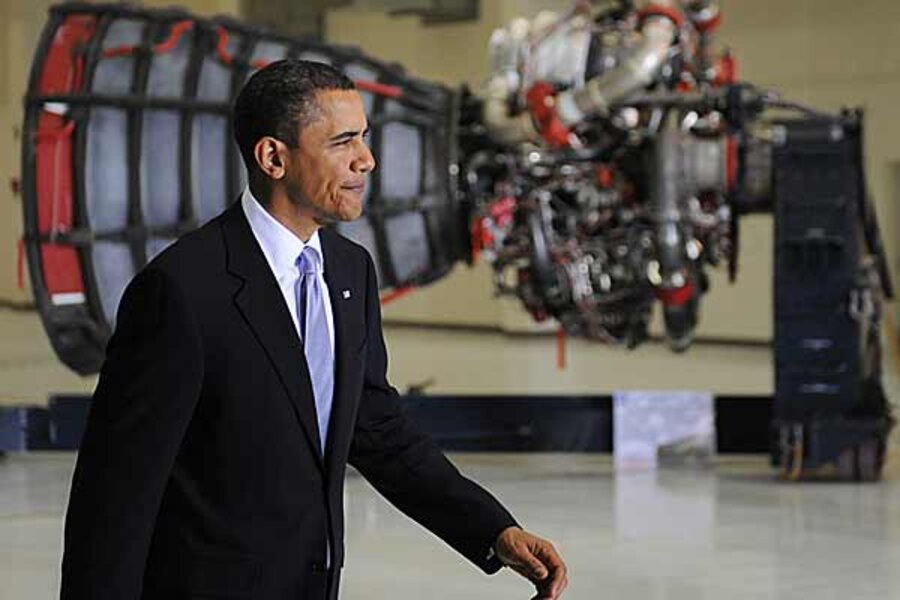Congressional tug-of-war holds NASA's new direction in the balance
Loading...
Not since the end of the Apollo program has the country's human-spaceflight program faced such a profound turning point, this time with little consensus on a new direction.
That accounts for the unusual, highly public tug-of-war over a new direction for NASA in Congress and within the broader spaceflight community that has marked the past several months.
"It really is pretty unprecedented," says Roger Launius, a spaceflight historian and curator of the Smithsonian Institution's National Air and Space Museum in Washington.
"Most of the time, people lock arms and agree that they're going to pursue a particular path," he says. When disagreements have arisen, they've tended to be modest and around the edges. "That's not true anymore," Dr. Launius says.
The debate essentially pits so-called "new space" advocates and entrepreneurs against some long-established aerospace interests. Ironically, the situation finds some key Republican lawmakers supporting a (relatively) large government-only approach to human spaceflight instead of supporting a budding and increasingly competent private-sector approach, as the Democratic president has proposed.
In February, President Obama proposed a significant change in direction for the agency, based largely on the counsel of an advisory panel the White House appointed last summer to present options for the human spaceflight program's future. In essence, the White House argued that its plan would place NASA's human-spaceflight emphasis on exploration beyond low-Earth orbit instead of on building a rocket as part of what had become a fiscally unsustainable program to provide regular cargo and crew service to the International Space Station.
To accomplish that, the president's proposed budget aimed to beef-up efforts to nurture the commercial launch sector, for instance, and strengthen research into new technologies, including rocket motors, that would reduce the launch costs of a new heavy-lift rocket and support direct human exploration of the solar system.
Both houses of Congress have had little trouble agreeing to meet the president's overall request to authorize $19 billion for the agency for fiscal 2011.
Not so with the direction for NASA's human-spaceflight portfolio.
In early August, the Senate passed an authorization bill that bears some resemblance to the President's original blueprint – but with scaled back support for the commercial-launch sector and an accelerated timetable for building a rocket powerful enough to loft people and hardware beyond low-Earth orbit. That rocket, the Senate said, should be based on space-shuttle-derived components.
The House has yet to pass its NASA authorization bill, but it looks significantly different – much more like the Constellation program the president's plan aimed to replace. Constellation included two rockets – one for astronauts, one for cargo – a manned capsule, and a development program for hardware that would be used for an outpost on the moon. The House plan spends less on technology development than even the Senate's reduced amount for R&D, and it cuts out money for robotic "scout" missions to the objects astronauts would eventually explore.
Fourteen Nobel laureates in the sciences signed a letter in late August critical of the House measure for its impact on R&D, efforts to nurture the commercial sector, and other elements of the bill.
The cuts were a way to keep NASA's budget to $19 billion while continuing a Constellation-like program, offers Louis Friedman, co-founder of the Planetary Society in Pasadena, Calif., which also has opposed the House version.
But, the House version, or something akin to it, has supporters as well.
Former NASA administrator Michael Griffin, who put the Constellation program in motion after President George W. Bush appointed him in 2005, noted in remarks at a space-policy roundtable in Washington last week that the Senate measure represents "a more mature" approach to exploration than the White House plan, and that the House version is better yet.
The best outcome, he reportedly told to attendees, was a blend of the best of the House and Senate versions.
But "best" appears to be in the eye of the beholder. "Best" is being argued as much on economic and ideological grounds as on technical and fiscal merit, analysts say. The issue of jobs looms large in an economy still struggling with what some have dubbed "the great recession."
On Capitol Hill, some staff members suggest that if a NASA authorization bill has a hope of passing before the end of the year, the House will have to move much closer to the Senate version -- itself a carefully brokered compromise trying to balance jobs through a shuttle-derived rocket with a new direction for the agency.
If the current version of the House bill passes, a conference committee to reconcile the House and Senate bills is unlikely to occur before year's end, requiring a continuing resolution to fund the agency until the requisite authorization and appropriations bills pass.
Dr. Freidman suggests another alternative – a meltdown at the authorization level would leave the task of hammering out a budget for NASA to the relevant appropriations committees.
"Maybe they can take a less partisan and a more considered view of all that's going on," he says.





